engine coolant FIAT FULLBACK 2017 Owner handbook (in English)
[x] Cancel search | Manufacturer: FIAT, Model Year: 2017, Model line: FULLBACK, Model: FIAT FULLBACK 2017Pages: 312, PDF Size: 12.31 MB
Page 213 of 312
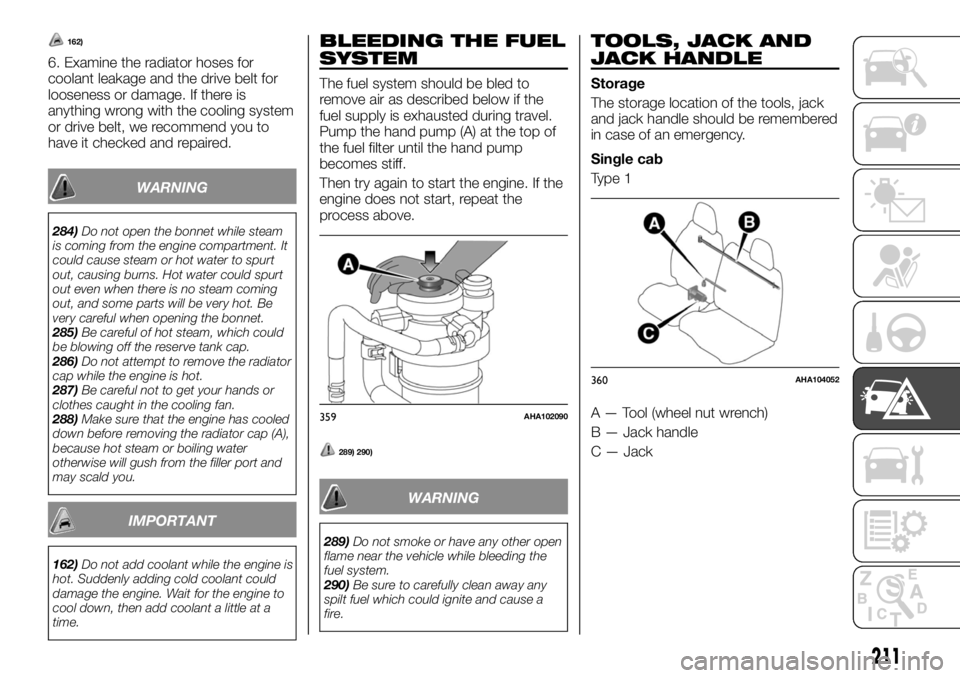
162)
6. Examine the radiator hoses for
coolant leakage and the drive belt for
looseness or damage. If there is
anything wrong with the cooling system
or drive belt, we recommend you to
have it checked and repaired.
WARNING
284)Do not open the bonnet while steam
is coming from the engine compartment. It
could cause steam or hot water to spurt
out, causing burns. Hot water could spurt
out even when there is no steam coming
out, and some parts will be very hot. Be
very careful when opening the bonnet.
285)Be careful of hot steam, which could
be blowing off the reserve tank cap.
286)Do not attempt to remove the radiator
cap while the engine is hot.
287)Be careful not to get your hands or
clothes caught in the cooling fan.
288)Make sure that the engine has cooled
down before removing the radiator cap (A),
because hot steam or boiling water
otherwise will gush from the filler port and
may scald you.
IMPORTANT
162)Do not add coolant while the engine is
hot. Suddenly adding cold coolant could
damage the engine. Wait for the engine to
cool down, then add coolant a little at a
time.
BLEEDING THE FUEL
SYSTEM
The fuel system should be bled to
remove air as described below if the
fuel supply is exhausted during travel.
Pump the hand pump (A) at the top of
the fuel filter until the hand pump
becomes stiff.
Then try again to start the engine. If the
engine does not start, repeat the
process above.
289) 290)
WARNING
289)Do not smoke or have any other open
flame near the vehicle while bleeding the
fuel system.
290)Be sure to carefully clean away any
spilt fuel which could ignite and cause a
fire.
TOOLS, JACK AND
JACK HANDLE
Storage
The storage location of the tools, jack
and jack handle should be remembered
in case of an emergency.
Single cab
Type 1
A — Tool (wheel nut wrench)
B — Jack handle
C — Jack
359AHA102090
360AHA104052
211
Page 245 of 312
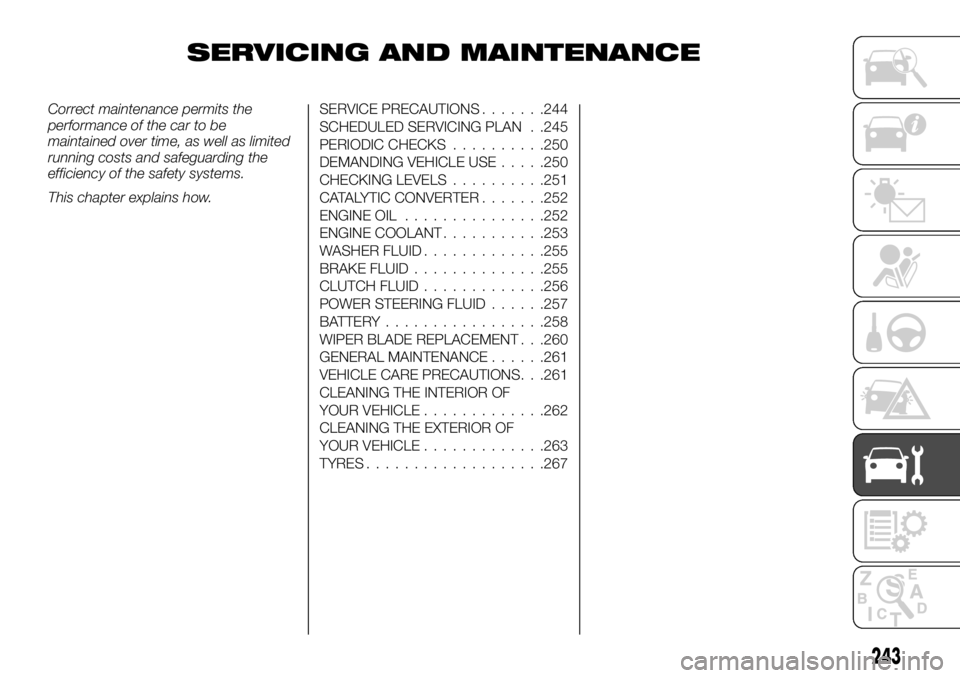
SERVICING AND MAINTENANCE
Correct maintenance permits the
performance of the car to be
maintained over time, as well as limited
running costs and safeguarding the
efficiency of the safety systems.
This chapter explains how.SERVICE PRECAUTIONS.......244
SCHEDULED SERVICING PLAN . .245
PERIODIC CHECKS..........250
DEMANDING VEHICLE USE.....250
CHECKING LEVELS..........251
CATALYTIC CONVERTER.......252
ENGINE OIL...............252
ENGINE COOLANT...........253
WASHER FLUID.............255
BRAKE FLUID..............255
CLUTCH FLUID.............256
POWER STEERING FLUID......257
BATTERY.................258
WIPER BLADE REPLACEMENT . . .260
GENERAL MAINTENANCE......261
VEHICLE CARE PRECAUTIONS. . .261
CLEANING THE INTERIOR OF
YOUR VEHICLE.............262
CLEANING THE EXTERIOR OF
YOUR VEHICLE.............263
TYRES...................267
243
Page 247 of 312
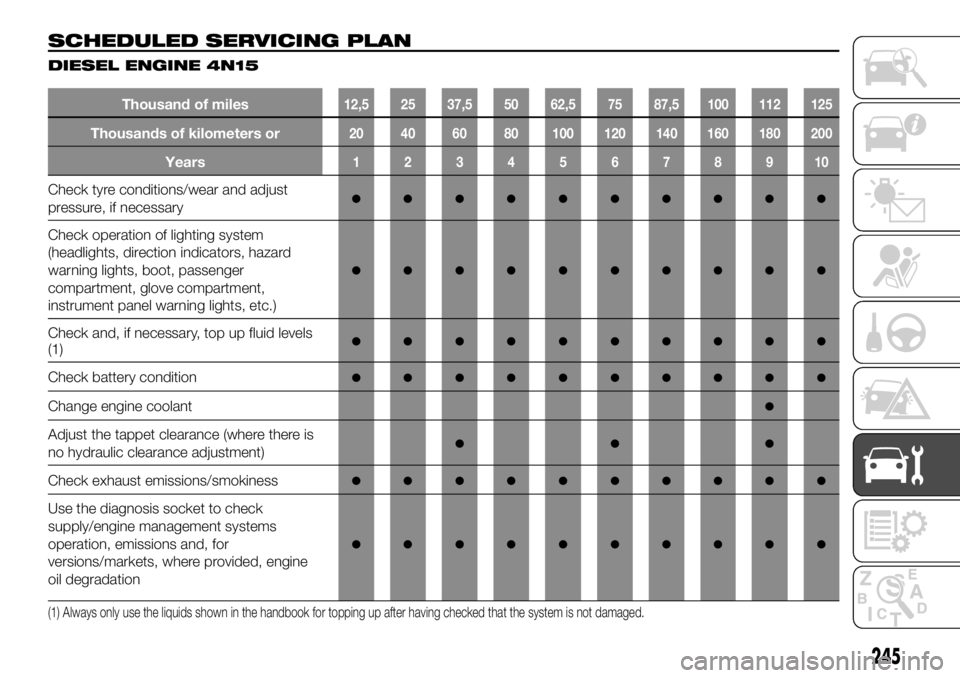
SCHEDULED SERVICING PLAN
DIESEL ENGINE 4N15
Thousand of miles12,5 25 37,5 50 62,5 75 87,5 100 112 125
Thousands of kilometers or20 40 60 80 100 120 140 160 180 200
Years12345678910
Check tyre conditions/wear and adjust
pressure, if necessary●●●●●●●●●●
Check operation of lighting system
(headlights, direction indicators, hazard
warning lights, boot, passenger
compartment, glove compartment,
instrument panel warning lights, etc.)
●●●●●●●●●●
Check and, if necessary, top up fluid levels
(1)●●●●●●●●●●
Check battery condition●●●●●●●●●●
Change engine coolant●
Adjust the tappet clearance (where there is
no hydraulic clearance adjustment)●●●
Check exhaust emissions/smokiness●●●●●●●●●●
Use the diagnosis socket to check
supply/engine management systems
operation, emissions and, for
versions/markets, where provided, engine
oil degradation
●●●●●●●●●●
(1) Always only use the liquids shown in the handbook for topping up after having checked that the system is not damaged.
245
Page 252 of 312
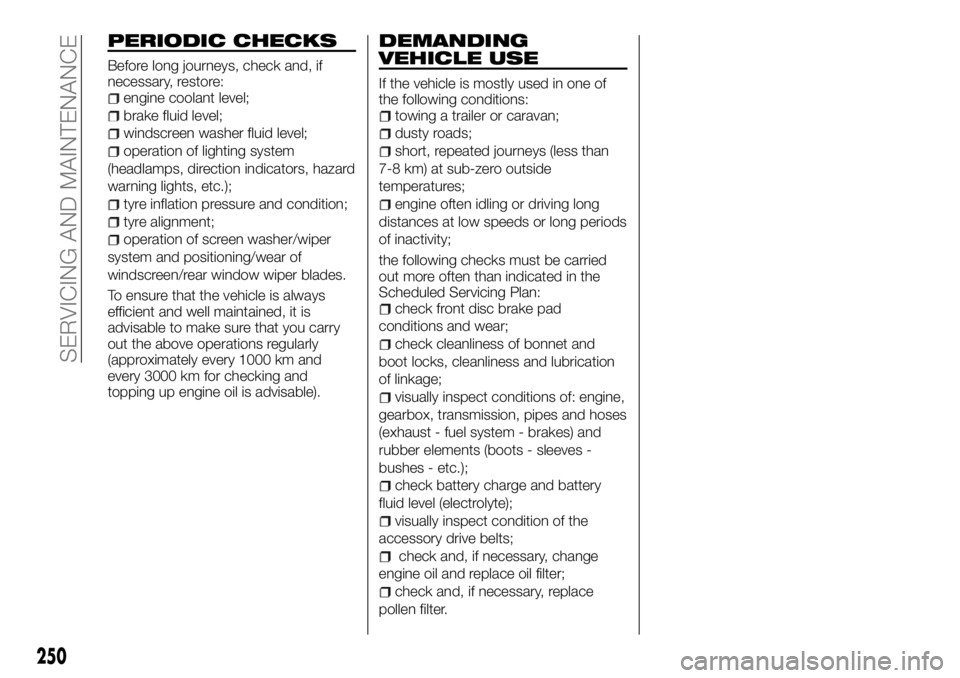
PERIODIC CHECKS
Before long journeys, check and, if
necessary, restore:
engine coolant level;
brake fluid level;
windscreen washer fluid level;
operation of lighting system
(headlamps, direction indicators, hazard
warning lights, etc.);
tyre inflation pressure and condition;
tyre alignment;
operation of screen washer/wiper
system and positioning/wear of
windscreen/rear window wiper blades.
To ensure that the vehicle is always
efficient and well maintained, it is
advisable to make sure that you carry
out the above operations regularly
(approximately every 1000 km and
every 3000 km for checking and
topping up engine oil is advisable).
DEMANDING
VEHICLE USE
If the vehicle is mostly used in one of
the following conditions:
towing a trailer or caravan;
dusty roads;
short, repeated journeys (less than
7-8 km) at sub-zero outside
temperatures;
engine often idling or driving long
distances at low speeds or long periods
of inactivity;
the following checks must be carried
out more often than indicated in the
Scheduled Servicing Plan:
check front disc brake pad
conditions and wear;
check cleanliness of bonnet and
boot locks, cleanliness and lubrication
of linkage;
visually inspect conditions of: engine,
gearbox, transmission, pipes and hoses
(exhaust - fuel system - brakes) and
rubber elements (boots - sleeves -
bushes - etc.);
check battery charge and battery
fluid level (electrolyte);
visually inspect condition of the
accessory drive belts;
check and, if necessary, change
engine oil and replace oil filter;
check and, if necessary, replace
pollen filter.
250
SERVICING AND MAINTENANCE
Page 253 of 312
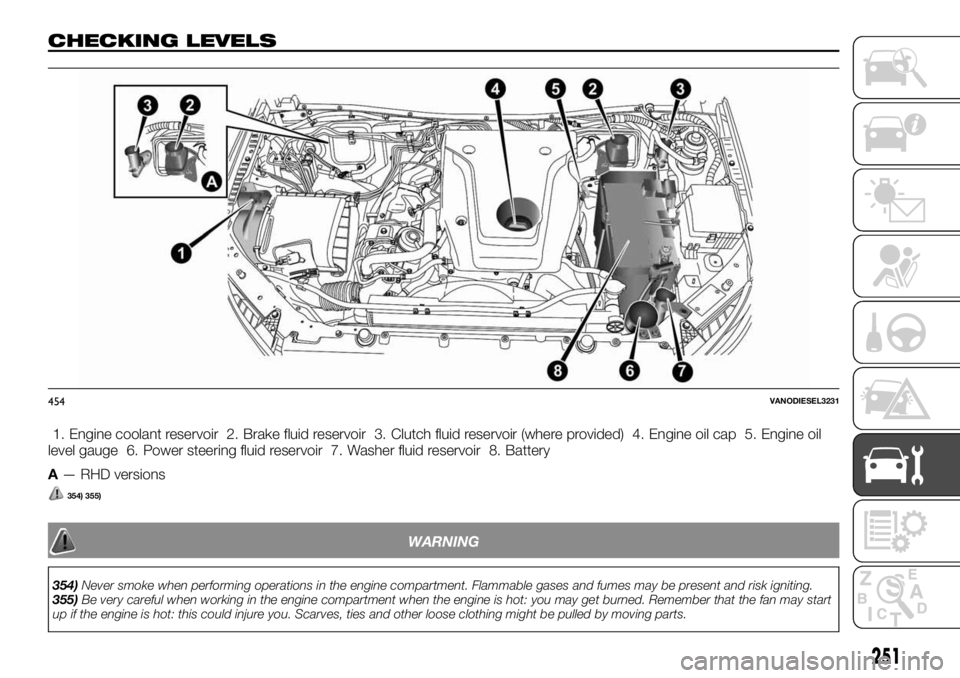
CHECKING LEVELS
1. Engine coolant reservoir 2. Brake fluid reservoir 3. Clutch fluid reservoir (where provided) 4. Engine oil cap 5. Engine oil
level gauge 6. Power steering fluid reservoir 7. Washer fluid reservoir 8. Battery
A— RHD versions
354) 355)
WARNING
354)Never smoke when performing operations in the engine compartment. Flammable gases and fumes may be present and risk igniting.
355)Be very careful when working in the engine compartment when the engine is hot: you may get burned. Remember that the fan may start
up if the engine is hot: this could injure you. Scarves, ties and other loose clothing might be pulled by moving parts.
454VANODIESEL3231
251
Page 255 of 312
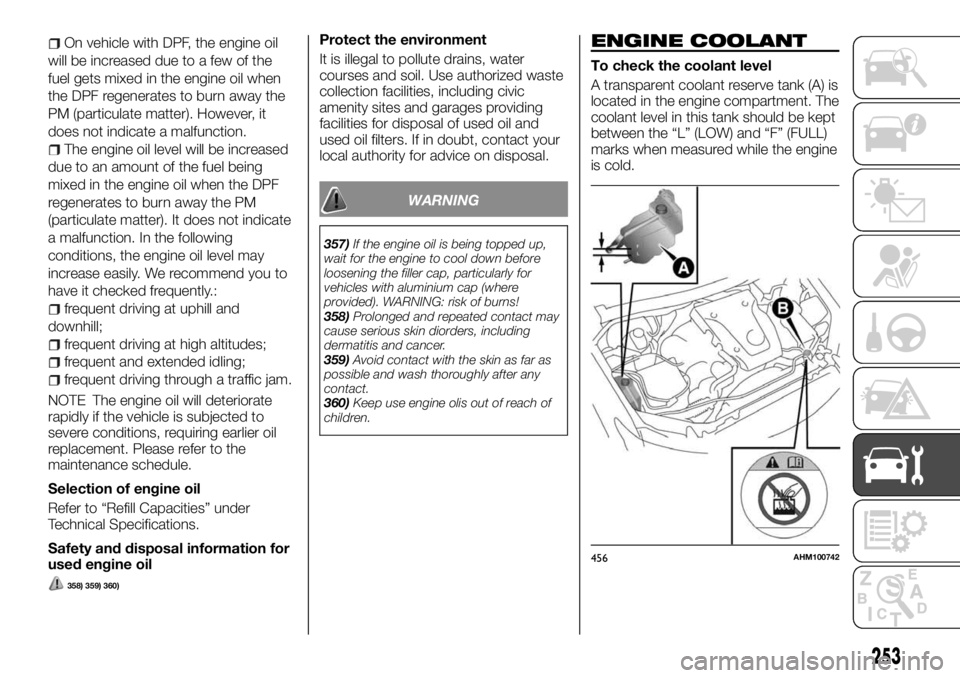
On vehicle with DPF, the engine oil
will be increased due to a few of the
fuel gets mixed in the engine oil when
the DPF regenerates to burn away the
PM (particulate matter). However, it
does not indicate a malfunction.
The engine oil level will be increased
due to an amount of the fuel being
mixed in the engine oil when the DPF
regenerates to burn away the PM
(particulate matter). It does not indicate
a malfunction. In the following
conditions, the engine oil level may
increase easily. We recommend you to
have it checked frequently.:
frequent driving at uphill and
downhill;
frequent driving at high altitudes;
frequent and extended idling;
frequent driving through a traffic jam.
NOTE The engine oil will deteriorate
rapidly if the vehicle is subjected to
severe conditions, requiring earlier oil
replacement. Please refer to the
maintenance schedule.
Selection of engine oil
Refer to “Refill Capacities” under
Technical Specifications.
Safety and disposal information for
used engine oil
358) 359) 360)
Protect the environment
It is illegal to pollute drains, water
courses and soil. Use authorized waste
collection facilities, including civic
amenity sites and garages providing
facilities for disposal of used oil and
used oil filters. If in doubt, contact your
local authority for advice on disposal.
WARNING
357)If the engine oil is being topped up,
wait for the engine to cool down before
loosening the filler cap, particularly for
vehicles with aluminium cap (where
provided). WARNING: risk of burns!
358)Prolonged and repeated contact may
cause serious skin diorders, including
dermatitis and cancer.
359)Avoid contact with the skin as far as
possible and wash thoroughly after any
contact.
360)Keep use engine olis out of reach of
children.
ENGINE COOLANT
To check the coolant level
A transparent coolant reserve tank (A) is
located in the engine compartment. The
coolant level in this tank should be kept
between the “L” (LOW) and “F” (FULL)
marks when measured while the engine
is cold.
456AHM100742
253
Page 256 of 312
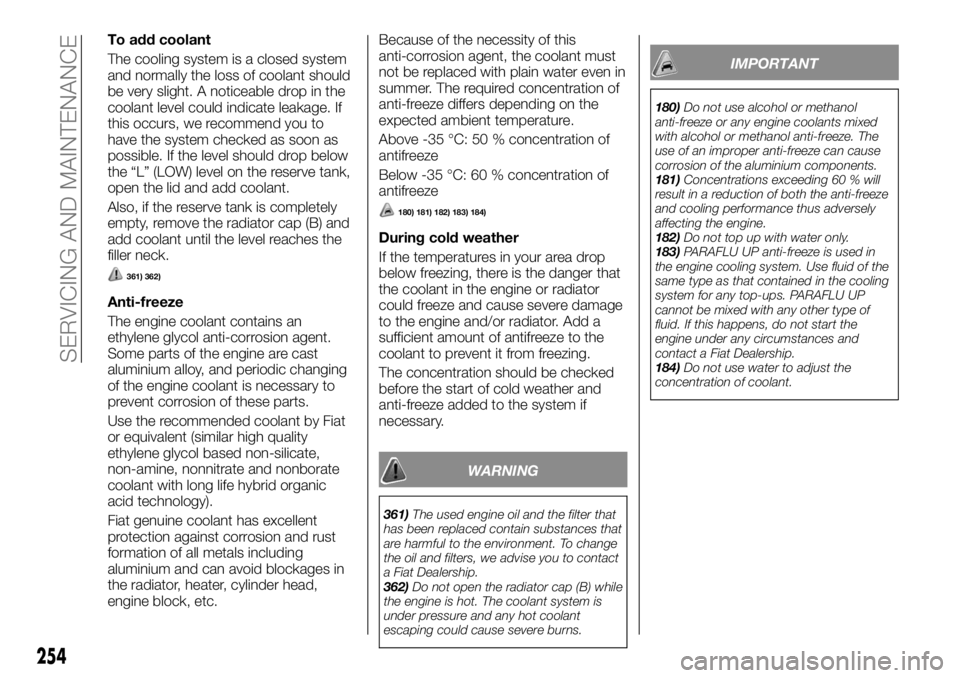
To add coolant
The cooling system is a closed system
and normally the loss of coolant should
be very slight. A noticeable drop in the
coolant level could indicate leakage. If
this occurs, we recommend you to
have the system checked as soon as
possible. If the level should drop below
the “L” (LOW) level on the reserve tank,
open the lid and add coolant.
Also, if the reserve tank is completely
empty, remove the radiator cap (B) and
add coolant until the level reaches the
filler neck.
361) 362)
Anti-freeze
The engine coolant contains an
ethylene glycol anti-corrosion agent.
Some parts of the engine are cast
aluminium alloy, and periodic changing
of the engine coolant is necessary to
prevent corrosion of these parts.
Use the recommended coolant by Fiat
or equivalent (similar high quality
ethylene glycol based non-silicate,
non-amine, nonnitrate and nonborate
coolant with long life hybrid organic
acid technology).
Fiat genuine coolant has excellent
protection against corrosion and rust
formation of all metals including
aluminium and can avoid blockages in
the radiator, heater, cylinder head,
engine block, etc.Because of the necessity of this
anti-corrosion agent, the coolant must
not be replaced with plain water even in
summer. The required concentration of
anti-freeze differs depending on the
expected ambient temperature.
Above -35 °C: 50 % concentration of
antifreeze
Below -35 °C: 60 % concentration of
antifreeze
180) 181) 182) 183) 184)
During cold weather
If the temperatures in your area drop
below freezing, there is the danger that
the coolant in the engine or radiator
could freeze and cause severe damage
to the engine and/or radiator. Add a
sufficient amount of antifreeze to the
coolant to prevent it from freezing.
The concentration should be checked
before the start of cold weather and
anti-freeze added to the system if
necessary.
WARNING
361)The used engine oil and the filter that
has been replaced contain substances that
are harmful to the environment. To change
the oil and filters, we advise you to contact
a Fiat Dealership.
362)Do not open the radiator cap (B) while
the engine is hot. The coolant system is
under pressure and any hot coolant
escaping could cause severe burns.
IMPORTANT
180)Do not use alcohol or methanol
anti-freeze or any engine coolants mixed
with alcohol or methanol anti-freeze. The
use of an improper anti-freeze can cause
corrosion of the aluminium components.
181)Concentrations exceeding 60 % will
result in a reduction of both the anti-freeze
and cooling performance thus adversely
affecting the engine.
182)Do not top up with water only.
183)PARAFLU UP anti-freeze is used in
the engine cooling system. Use fluid of the
same type as that contained in the cooling
system for any top-ups. PARAFLU UP
cannot be mixed with any other type of
fluid. If this happens, do not start the
engine under any circumstances and
contact a Fiat Dealership.
184)Do not use water to adjust the
concentration of coolant.
254
SERVICING AND MAINTENANCE
Page 263 of 312
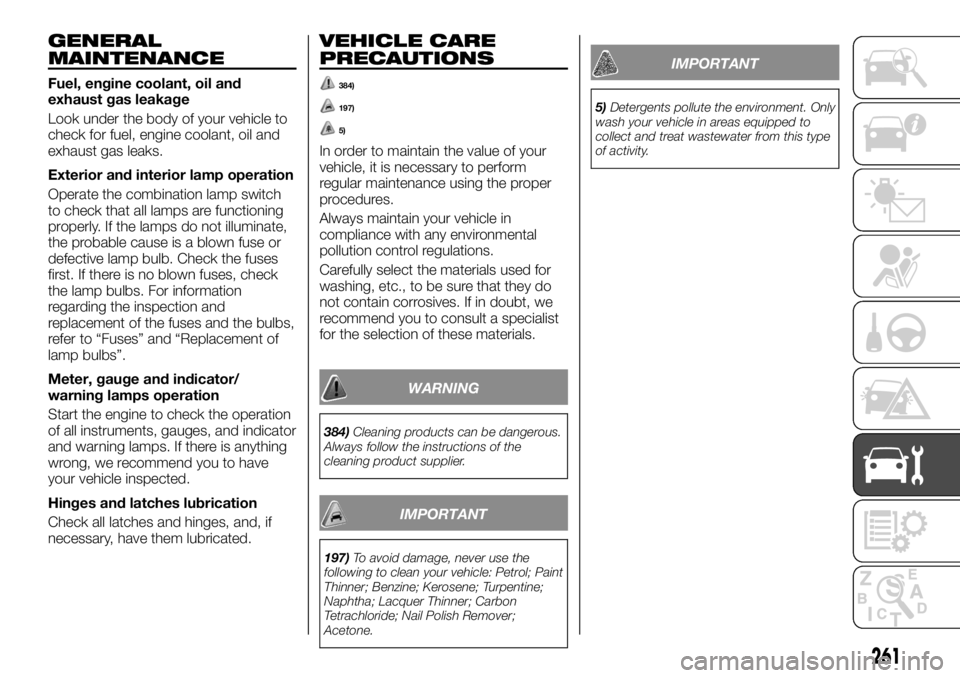
GENERAL
MAINTENANCE
Fuel, engine coolant, oil and
exhaust gas leakage
Look under the body of your vehicle to
check for fuel, engine coolant, oil and
exhaust gas leaks.
Exterior and interior lamp operation
Operate the combination lamp switch
to check that all lamps are functioning
properly. If the lamps do not illuminate,
the probable cause is a blown fuse or
defective lamp bulb. Check the fuses
first. If there is no blown fuses, check
the lamp bulbs. For information
regarding the inspection and
replacement of the fuses and the bulbs,
refer to “Fuses” and “Replacement of
lamp bulbs”.
Meter, gauge and indicator/
warning lamps operation
Start the engine to check the operation
of all instruments, gauges, and indicator
and warning lamps. If there is anything
wrong, we recommend you to have
your vehicle inspected.
Hinges and latches lubrication
Check all latches and hinges, and, if
necessary, have them lubricated.
VEHICLE CARE
PRECAUTIONS
384)
197)
5)
In order to maintain the value of your
vehicle, it is necessary to perform
regular maintenance using the proper
procedures.
Always maintain your vehicle in
compliance with any environmental
pollution control regulations.
Carefully select the materials used for
washing, etc., to be sure that they do
not contain corrosives. If in doubt, we
recommend you to consult a specialist
for the selection of these materials.
WARNING
384)Cleaning products can be dangerous.
Always follow the instructions of the
cleaning product supplier.
IMPORTANT
197)To avoid damage, never use the
following to clean your vehicle: Petrol; Paint
Thinner; Benzine; Kerosene; Turpentine;
Naphtha; Lacquer Thinner; Carbon
Tetrachloride; Nail Polish Remover;
Acetone.
IMPORTANT
5)Detergents pollute the environment. Only
wash your vehicle in areas equipped to
collect and treat wastewater from this type
of activity.
261
Page 292 of 312
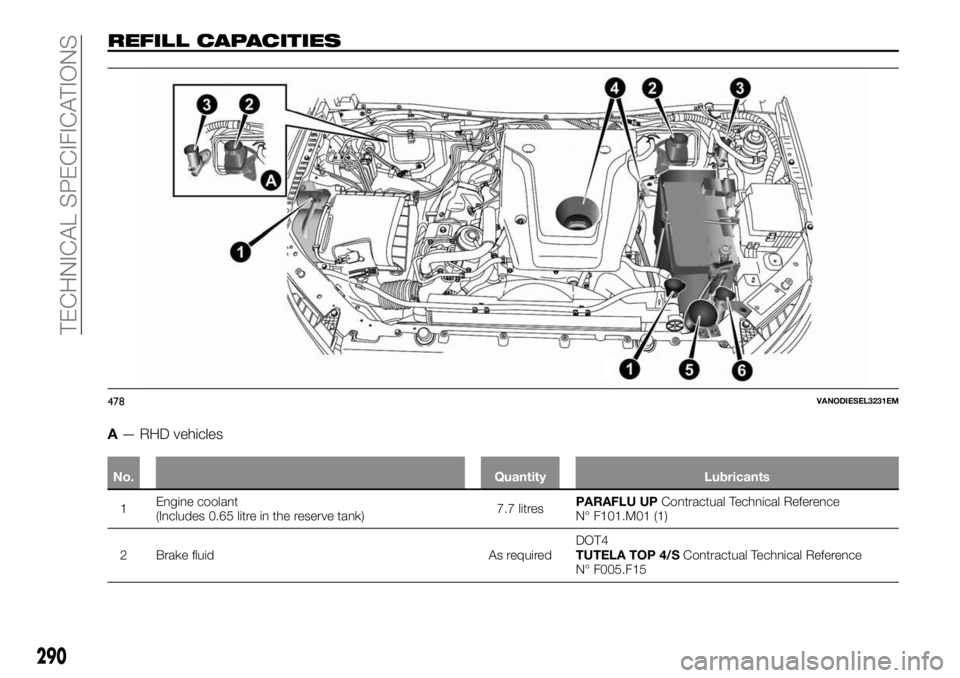
REFILL CAPACITIES
A— RHD vehicles
No. Quantity Lubricants
1Engine coolant
(Includes 0.65 litre in the reserve tank)7.7 litresPARAFLU UPContractual Technical Reference
N° F101.M01 (1)
2 Brake fluid As requiredDOT4
TUTELA TOP 4/SContractual Technical Reference
N° F005.F15
478VANODIESEL3231EM
290
TECHNICAL SPECIFICATIONS
Page 297 of 312
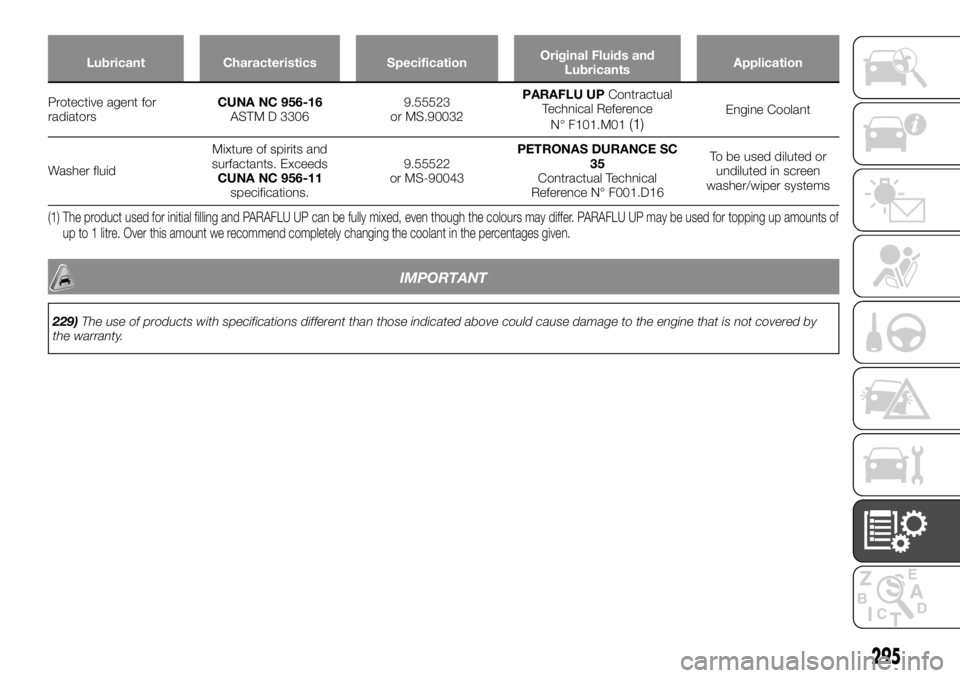
Lubricant Characteristics SpecificationOriginal Fluids and
LubricantsApplication
Protective agent for
radiatorsCUNANC 956-16
ASTM D 33069.55523
or MS.90032PARAFLU UPContractual
Technical Reference
N° F101.M01
(1)Engine Coolant
Washer fluidMixture of spirits and
surfactants. Exceeds
CUNA NC 956-11
specifications.9.55522
or MS-90043PETRONAS DURANCE SC
35
Contractual Technical
Reference N° F001.D16To be used diluted or
undiluted in screen
washer/wiper systems
(1) The product used for initial filling and PARAFLU UP can be fully mixed, even though the colours may differ. PARAFLU UP may be used for topping up amounts of
up to 1 litre. Over this amount we recommend completely changing the coolant in the percentages given.
IMPORTANT
229)The use of products with specifications different than those indicated above could cause damage to the engine that is not covered by
the warranty.
295